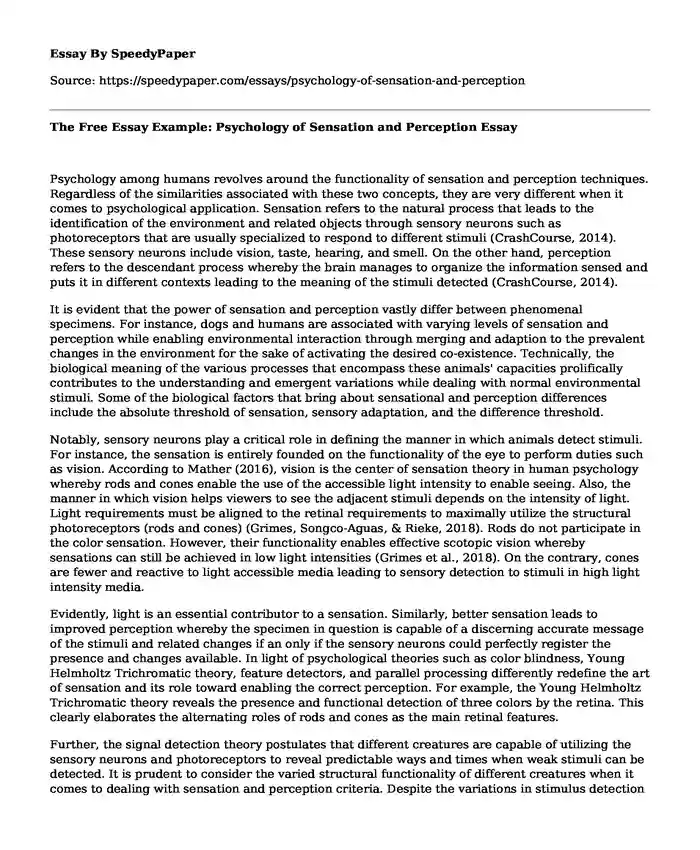
| Type of paper: | Essay |
| Categories: | Psychology Medicine |
| Pages: | 3 |
| Wordcount: | 688 words |
Psychology among humans revolves around the functionality of sensation and perception techniques. Regardless of the similarities associated with these two concepts, they are very different when it comes to psychological application. Sensation refers to the natural process that leads to the identification of the environment and related objects through sensory neurons such as photoreceptors that are usually specialized to respond to different stimuli (CrashCourse, 2014). These sensory neurons include vision, taste, hearing, and smell. On the other hand, perception refers to the descendant process whereby the brain manages to organize the information sensed and puts it in different contexts leading to the meaning of the stimuli detected (CrashCourse, 2014).
It is evident that the power of sensation and perception vastly differ between phenomenal specimens. For instance, dogs and humans are associated with varying levels of sensation and perception while enabling environmental interaction through merging and adaption to the prevalent changes in the environment for the sake of activating the desired co-existence. Technically, the biological meaning of the various processes that encompass these animals' capacities prolifically contributes to the understanding and emergent variations while dealing with normal environmental stimuli. Some of the biological factors that bring about sensational and perception differences include the absolute threshold of sensation, sensory adaptation, and the difference threshold.
Notably, sensory neurons play a critical role in defining the manner in which animals detect stimuli. For instance, the sensation is entirely founded on the functionality of the eye to perform duties such as vision. According to Mather (2016), vision is the center of sensation theory in human psychology whereby rods and cones enable the use of the accessible light intensity to enable seeing. Also, the manner in which vision helps viewers to see the adjacent stimuli depends on the intensity of light. Light requirements must be aligned to the retinal requirements to maximally utilize the structural photoreceptors (rods and cones) (Grimes, Songco-Aguas, & Rieke, 2018). Rods do not participate in the color sensation. However, their functionality enables effective scotopic vision whereby sensations can still be achieved in low light intensities (Grimes et al., 2018). On the contrary, cones are fewer and reactive to light accessible media leading to sensory detection to stimuli in high light intensity media.
Evidently, light is an essential contributor to a sensation. Similarly, better sensation leads to improved perception whereby the specimen in question is capable of a discerning accurate message of the stimuli and related changes if an only if the sensory neurons could perfectly register the presence and changes available. In light of psychological theories such as color blindness, Young Helmholtz Trichromatic theory, feature detectors, and parallel processing differently redefine the art of sensation and its role toward enabling the correct perception. For example, the Young Helmholtz Trichromatic theory reveals the presence and functional detection of three colors by the retina. This clearly elaborates the alternating roles of rods and cones as the main retinal features.
Further, the signal detection theory postulates that different creatures are capable of utilizing the sensory neurons and photoreceptors to reveal predictable ways and times when weak stimuli can be detected. It is prudent to consider the varied structural functionality of different creatures when it comes to dealing with sensation and perception criteria. Despite the variations in stimulus detection levels neural disorders such as prosopagnosia (face blindness) totally hinder perception of the faces. However, in other cases, a limited degree of sensation possibly enable different levels of perception. Technically, Ernst Heinrich Weber wraps up the psychological concepts around sensation and perception through a premise that the percentage of light matters. As a result, light amplitude easily triggers vision owing to the capacity to clearly see and make the rightful meaning.
References
CrashCourse. (Mar. 3, 2014). Sensation & Perception - Crash Course Psychology #5. [online]. Retrieved from: https://youtu.be/unWnZvXJH2o (Accessed: Mar 2nd, 2019).
Grimes, W. N., Songco-Aguas, A., & Rieke, F. (2018). Parallel processing of rod and cone signals: retinal function and human perception. Annual review of vision science, 4, 123-141. Retrieved from: https://www.ncbi.nlm.nih.gov/pmc/articles/PMC6153147/
Mather, G. (2016). Foundations of sensation and perception. Hove, East Sussex: Psychology Press. Retrieved from: http://psypress.com/mather/includes/FoundationsOfSensationandPerception.pdf
Cite this page
The Free Essay Example: Psychology of Sensation and Perception. (2022, Dec 08). Retrieved from https://speedypaper.com/essays/psychology-of-sensation-and-perception
Request Removal
If you are the original author of this essay and no longer wish to have it published on the SpeedyPaper website, please click below to request its removal:
- A Reflection Essay on Integrity for Free from Our Database
- Household Safety Essay Sample
- Free Essay: Chid Abuse in Child Welfare Services - A Human or a System Error?
- Interacting with RAD Essay Sample
- Free Essay on Personal Development and Self-awareness
- Essay Sample on Cruzan v. Director, Missouri Department of Health, 497 U.S. 261 (1990)
- Free Essay. Provisions Under Title VII That Employers Require to Follow
Popular categories




